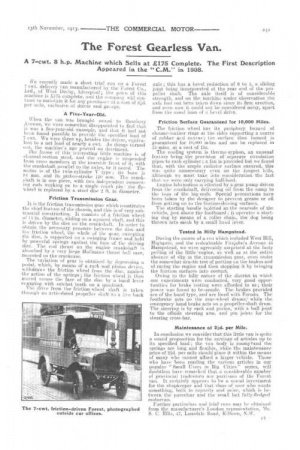The Forest Gearless Van.
Page 9

If you've noticed an error in this article please click here to report it so we can fix it.
We recently made a short trial run on a .Forest 7-ewt. delivery van manufactured by the Forest Co., Ltd., of West Derby, Liverpool ; the price of this machine is L.i75 complete, and the eoinpany will contract to maintain it for any purchaser at a cost of 2W. per mile, exclusive of driver and gai age.
A Five-Year-01d.
When the van was brought round to Rosehery Avenue, we were somewhat disappointed to find that it, was a five-year-old example, and that it had not been found possible to provide the specified load of 7 cwt. We were three up, besides the driver, equivalent to a net load of nearly 4 cwt. As things turned out, the machine's age proved no detriment The frame of this interesting little machine is of channel-section steel, and the engine is suspended from cross members at the nearside front of it, with the crankshaft parallel to the axles, be it noted. The motor is of the twin-cylinder V type ; its bore is mm. and its piston-stroke 110 mm. The crankshaft is in one piece, with two independent connecting rods working on to a single crank pin the flywheel is replaced by a steel disc 2 ft. in diameter.
Friction Transmission Gear.
It is the friction transmission gear which constitutes the chief feature of the chassis, and this is of very substantial construction. It consists of a friction wheel of 14 in. diameter, sliding on a squared shaft, and this is driven by the disc on the crankshaft. In order to obtain the necessary pressure between the disc and the friction wheel, the whele of the gear, excepting the disc, is supported on a swinging frame and held by powerful springs against the face of the driving disc. The end thrust on the engine crankshaft is absorbed by a very large Hoffmann thrust ball race, mounted on the crankcase.
The variation of gear is obtained by depressing a pedal, which, by means of a rack and pinion device, withdraws the friction wheel from the disc, against the action of the springs ; the friction wheel is then moved across the face of the disc by a hand lever engaging with ratchet teeth on a quadrant. The drive from the friction-wheel shaft is taken through an articulated propeller shaft to a live back
axle ; this has a bevel reduction of 6 to 1, a sliding joint being incorporated at the rear end of the propeller shaft. The axle itself is of considerable strength, and on the machine under 'Observation the axle had not been taken down since its first erection, and even now it could not be considered noisy, apart from tfie usual hum of a Level drive.
Friction Surface Guaranteed for 10,000 Miles.
The friction wheel has its periphery formed of chrome-leather rings at the sides supporting a centre of rubber tied canvas ; the surface thus formed is guaranteed for 10,000 miles and can be replaced in 15 mins. at a cost of 15s.
The cooling system is thermo-syphon, an unusual feature being the provision of separate circulation pipes to each cylinder ; a fan is provided but we found that, with the ample radiator surface ensured, this was quite unnecessary even on the longest although we must take into consideration the fact that we were only carrying half-load. Enciine lubrication is effected by a gear pump driven from the crankshaft, delivering oil from the sump to the tops of the big-ends. Special precautions have been taken by the designer to prevent grease or oil from getting on to the friction-driving surfaces.
The starting handle is;idted at the nearside of the vehicle, just above the footboard ; it operates a starting dog by means of a roller chain, the dog being thrown into mesh by a small hand lever.
Tested in Hilly Hampstead.
During the course of a run which included West Hill, Highgate, and the redoubtable Fitzjohn's Avenue in Hampstead, we were agreeably surprised at the lusty pulling of the little'engine, as well as at the entire absence of slip in thestransmission gear, even under the somewhat drastic test of putting on the brakes and of racing the engine and then stopping it by bringing the friction surfaces into contact. •
Owing to the hilly nature of the district in which our experiments were conducted, very good opportunities for brake testing were afforded to us ; their power was found to he ample. The brakes provided are of the band type, and are lined with Ferodo. The footbrake acts on the rear-wheel drums;' while the emergency hand brake acts on a, propeller-shaft drum. The steering is by rack and pinion, _with a ball joint to the offside steering arm, and pm joints for the steering cross-bar.
Maintenance at 2id. per Mite.
In conclusion we consider that this little van is quite a sound proposition for the carriage of articles up to its specified load; the van body is roomyland the springs are long and flexible, while the maintenance price of Ved. per mile should place it within the means of many who cannot afford a larger vehicle. Those who have 'been reading the various articles in our popular "Small Users in Big Cities' ' series, will doubtless have remarked that a considerable number of provincial tradesmen are partisans of the Forest van. It certainly appears to be a sound investment for the shopkeeper and that class of user who wants something, both in capacity and price, which is between the parcelcar and the small but fully-fledged motorvan.
Further particulars and trial runs may be obtained • from the manufacturer's London representative, Mr. S. C. Ellis, 47, Lonschile Road, -Kilburn• NW.
























